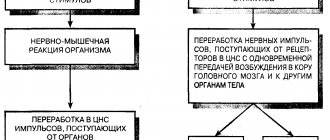Emotions accompany us from birth until death, but few people realize how important emotions are. What are emotions? Emotions are a person’s attitude towards various events occurring in his life. It should be noted that emotions have been studied very poorly by scientists. Therefore, the opinions of the authors regarding such a concept as human emotions differ greatly.
In order to understand what emotions are, it is necessary to draw a general conclusion based on all opinions. Emotions are a person’s reaction to current events. They have a great influence on human activity, and in most cases are responsible for his actions.
This means that thanks to emotions, a person is able to experience feelings such as fear, joy, anger, pleasure, hatred and others.
Emotions are not the cause of experiences. They only regulate human activity.
Emotions have accompanied humanity since ancient times. They have gone through a long period of evolution and have changed a lot since the beginning of life. At first, emotions could be called the primitive instincts of man, for example, movement and other actions inherent in man by nature. In the process of evolution, they developed, acquiring an emotional character and lost their instinctive character. Thus, instincts acquired individuality and allowed a person to evaluate the current situation, as well as take part in it at his own discretion.
Introduction
In the age of scientific and technological progress, when modern people spend more and more time in front of a computer monitor, when the proportion of live communication is becoming less and less, and the quality of communication is undergoing significant changes due to the replacement of people in various fields of activity by “smart machines,” emotional experience remains necessary and priority for a person, as one of the sources of enriching the inner world of the individual, as one of the sources of knowledge of the surrounding reality.
Psychologists, as well as philosophers and educators, do not have a consensus regarding the role that emotions play in human life. Thus, even though intelligence has become a means of production and science has become a destiny, some still tend to classify man as emotional or perhaps emotional-social. In their opinion, the very meaning of our existence is affective, emotional: we surround ourselves with those people and things to which we are emotionally attached. They argue that learning through experience (both personal and social) is as important, if not more important, than the accumulation of information.
Leeper, a leading personality theorist, and Maurer, a prominent expert in the field of learning psychology, were among the first to speak out about the important role of emotions in human behavior. Maurer argued that “emotion is one of the most important, indeed indispensable, factors in those changes in behavior or its results that we call “learning.”
Emotions or emotional experiences are usually understood as a variety of human reactions, from violent outbursts of passion to subtle gradations of mood. In psychology, emotions are processes that reflect, in the form of experiences, personal meaning and assessment of external and internal situations for a person’s life.
Most people know what situations make them interested, disgusted, angry or guilty. Almost every person experiences interest when he sees an astronaut walking in space, disgust when he sees dirt, anger when he is insulted, and guilt when he shirks responsibility for his loved ones.
Thus, the lack of emotional communication, intimate contact between the baby and mother leads to poor development of the baby, frequent illnesses, defective emotionality, coldness, and low ability for empathy and compassion. And without all this, a child will not be able to become a full-fledged member of society when he grows up.
From this we can conclude that human behavior is determined not only by the action of elementary needs and instincts. Emotions reflect the world around us and regulate our behavior accordingly. This is not just an assessment of completed actions. In order to understand concepts such as value, meaning, courage, loyalty, empathy, altruism, pity, pride, compassion and love, we must recognize the existence and critical role of human emotions. This explains the relevance of our research.
Purpose of the study: to study the role of emotions in human life.
To achieve this goal, the following tasks were formulated:
- the study of emotions as a special class of mental processes.
- consider the functions of emotions in human life.
- determine the nature of the interaction between emotions and personality activity.
- 4.Identify the influence of emotions on human cognitive activity.
Subject of research: emotions as a mental process.
Object of study: the influence of emotions on cognitive processes and human activity.
Research methods: theoretical analysis of scientific psychological and pedagogical literature on this aspect.
Despite the fact that scientists have not yet come to a consensus on the nature of emotions and their meaning, theoretical and practical achievements of recent decades make it possible to consider emotions in all the diversity of approaches to the study of this problem in its most diverse aspects.
Example of positive manipulation
In the film “The Taste of Life”* a child who has lost his parents categorically refuses to eat for a long time, despite all the persuasion of those around him. There is an episode in the film when a girl is sitting in the kitchen of a restaurant. The young chef, knowing that she does not eat, first hangs around her for a while, preparing spaghetti for himself and telling all the nuances of the recipe, and then eats it appetizingly, sitting next to her. At some point, he is asked to go out into the hall to meet clients, and he seems to mechanically thrust a plate of spaghetti into the girl’s hands. After hesitating for a while, she begins to eat...
*"Taste of Life" (English: No Reservations) is a 2007 romantic comedy. The film was directed by Scott Hicks from a script by Carol Fuchs, based on the work of Sandra Nettlebeck. This is a remake of the German film "Martha Irresistible". The American version stars Catherine Zeta-Jones and Aaron Eckhart, who played a couple of chefs in this film. Note ed.
General characteristics of emotions
Currently, most psychologists believe that emotions are not a simple phenomenon. And therefore, there are many approaches to defining the concept of “emotion”: Some researchers consider emotions as short-term phenomena, others are convinced that people are constantly under the influence of one or another emotion. Some scientists believe that emotions destroy and disrupt human behavior. In contrast, others argue that emotions play a positive role in organizing, motivating, and reinforcing behavior. However, they all agree on one thing: any definition of emotion must take into account three aspects that characterize it:
1) experienced or perceived feeling of emotion (impressive);
2) processes occurring in the nervous, hormonal, respiratory, digestive and other systems of the body (physiological);
3) observable expressive complexes of emotion, especially those reflected on the face (expressive).
It should be noted that the emotional world of the individual remained unexplored for a long time; it was simply not given due attention. Researchers in this area of psychology have expressed many theories about the origin and nature of emotions. But this phrase has its own drawback - there is no single and accurate definition of emotion. Each researcher, based on his own views, offers his own definition of emotion.
Let's take a look at them.
Lebedinsky says that emotion is one of the most important aspects of mental processes that characterizes a person’s experience of reality.
PK Anokhin understands emotions as physiological states of the body, which have a pronounced subjective nature and include all types of human feelings and experiences - from deep traumatic suffering to high forms of joy and social sensations of life.
According to Reikowski, emotional processes are a specific class of mental regulation processes that are triggered by factors that are significant to the individual.
4) Emotions are subjective reactions of people and animals to the action of internal and external stimuli, expressed in pleasure or displeasure, joy, fear, and so on.
5) accompanying almost all manifestations of the body’s vital activity, emotions reflect in the form of direct experience the meaning (meaning) of phenomena and situations and serve as one of the main mechanisms of internal regulation of mental activity and behavior aimed at satisfying current needs (Leontyev, Sudakov).
Wecker, in his book Mental Processes, says that definitions of emotions include the concept of “relationships”, since emotions are closest to the relationship of the subject with the objects around him and are part of the context of important life events.
If we consider emotions as experiences of events and relationships, as opposed to cognitive processes as knowledge about these events and relationships, then this definition will be inadequate, if only because it describes emotions in terms of specific attributes and does not cover the generic attribute.
Wekker leads us to the conclusion that “there is no reason to build a definition of emotion, taking this concept beyond the term “reflection” or comparing the terms “reflection”, “experience” and “expression” and including them in one type. “Emotion” as a species located within its narrow genus (mental processes), remains at the same time within the broader scope of the term “reflection”.
Let us dwell on the following definition of this mental process, which, in our opinion, better reflects the essence of the concept under study.
So, emotions are a special class of mental processes and states associated with the instincts, needs and motives of the individual. Emotions perform the function of regulating the subject’s activity, reflecting the significance of external and internal situations for the implementation of his life activities.
Emotions play a very important role in human life. Although they are different from other mental processes, they are difficult to separate because they merge into a single human experience.
In the works of V.V. Davydov devoted to developmental education, it is shown that emotional processes play the role of “mechanisms of emotional fixation” and the formation of affective complexes.
The most essential feature of emotions is their subjectivity. If mental processes such as perception and thinking allow a person to more or less objectively reflect the world around him and beyond his control, then emotions serve to reflect a person’s subjective attitude towards himself and the world around him. It is equally important that emotions are not only recognized and understood, but also experienced. A person takes a certain position in relation to an event. And this position is always biased because it does not give a purely rational assessment, but includes emotional experiences.
Important characteristics of emotions are their intensity and depth. The intensity of an emotion is understood as the degree of activation of the central nervous system. According to D.B. Linsley, who conducted electrophysiological studies, there are two polar meanings of activation of a person’s emotional state: a state of coma or deep sleep, in which reflexes disappear and which cannot be disturbed even by strong stimuli, and a state of extreme excitement (ecstasy, attacks of insanity, panic, rage). Between these poles there are a number of intermediate states: Apathy, indifference, interest, alertness, excitement. These conditions are usually reversible and can merge depending on external or internal stimulus.
Influence
As mentioned above, emotions have a great influence on a person’s life. Some people don't tend to give in to emotions. They experience them, but cannot fully feel them. Such people can be called dispassionate and cold. They are unable to correctly assess their own feelings.
Human emotions really have not only a moral, but also a physical impact on a person. For example, if a person experiences severe fear, he is unable to think or make sudden movements. The body of a person experiencing fear may become numb, and in some cases he wants to run away without looking back.
Being sad, a person is unable to take an active part in the life of society. He wants to quickly hide from the world around him, does not want to carry on a conversation and prefers loneliness.
Joy also changes a person's life. Positive emotions contribute to the production of the happiness hormone. A person feels an unexpected surge of strength, and readily begins new achievements.
Long-term stress can have a serious impact on human health. Negative emotions contribute to the deterioration of the cardiovascular system. Impaired heart function can lead to serious consequences. Continuous negative emotions have a detrimental effect on the human body.
It is also worth noting a separate group of human emotions. Affects are very strong human emotions. In such a state, a person can commit an unexpected, unusual act. In some cases it is hatred, fear or a desire to protect oneself.
Also watch the webinar on managing emotions from Denis Burkhaev.
Functions of emotions
To understand the role emotions play in our lives, we must first consider the basic functions of emotions. Answering the question of what role emotions play in the life of living beings, researchers identify several regulatory functions of emotions: reflexive (evaluative), impulsive, reinforcing, switching and communicative.
The reflective function of emotions is expressed in a generalized assessment of events. Emotions cover the entire body and represent an almost instantaneous and integral assessment of behavior as a whole, allowing one to determine the usefulness and harmfulness of the factors acting on the individual even before the localization of the harmful effects. An example is the behavior of a person who has suffered a limb injury. He concentrates on the pain and immediately finds a position that reduces the pain.
Emotion as a special internal state and subjective experience has the function of assessing the circumstances of the situation. Based on the need that has arisen and an intuitive idea of the possibilities of satisfying it. Emotional evaluation differs from the conscious cognitive evaluative operations of the mind in that it occurs at the sensory level.
P.V. Simonov emphasizes the reinforcing function of emotions. It is known that emotions are directly related to the processes of learning and memory. Significant events that cause emotional reactions are imprinted in memory faster and for a long time.
The switching function of emotions is that they often force a person to change his behavior. This function of emotions is most clearly manifested in extreme situations, when there is a struggle between the natural instinct of self-preservation and the social need to follow a certain ethical norm. The conflict of needs is experienced as a struggle between anxiety and a sense of duty, fear and shame. The result depends on the strength of the motives and personal attitude of the subject.
Let's reveal the essence of the motivational function of emotions. Their participation in controlling our behavior and activities has been discussed for a long time, even by the thinkers of Ancient Greece.
Rene Descartes spoke about the emotion of interest in managing human behavior and activity, namely the role of passion in memorization: “No matter how many times an unknown object appears in our field of vision, we will not retain it in memory if the idea of it has not been fixed in our brain with some passion.”
A distinctive feature of emotions is that they directly reflect the connection between motives and the performance of activities consistent with these motives. Although emotions themselves are not motives, they can act in the motivational process not only as amplifiers of the energy of motives, but also as motivational processes themselves, but not as actions to satisfy needs, but as motivational processes. They represent only the first step in the regulation of body processes, that is, they provide consciousness with the cause of such regulation and give it the first impetus. The motivational function of emotions is aspiration, desire, attraction directed towards or away from an object. Emotion highlights the search area in which a solution to a problem or satisfaction of a need must be found. Thus, emotions are a motivator and regulator of human behavior.
Emotions play an important role at all stages of the motivational process. When assessing the importance of an external stimulus, the main purpose of emotions is to give the body a signal about the benefit or harm of a particular phenomenon. Emotions reflect not only the biological meaning of external stimuli, but also the personal meaning. Emotions precede a person’s perception of a situation and signal a possible pleasant/unpleasant outcome of the event. They determine what is significant for a person and what is not, thereby facilitating his orientation in various situations.
When making a decision, emotions usually point to objects and actions that can lead to the satisfaction of a need and thus contribute to the decision. However, there is often not enough information to make a decision. Then emotions take on a compensatory function, that is, they replace the missing information. For example, when we encounter an unfamiliar object, emotion gives this object an appropriate coloring (whether it is good or bad, whether we like it or not), usually in comparison with previously encountered objects. Although a person more often uses emotions for a generalized and not always justified assessment of an object and situation, they still help him get out of a dead end when he does not know how to act in a given situation. In these cases, the role of emotions is to urgently replace, to compensate for the lack of knowledge at the moment.
An important function of emotions is the communicative function. Facial expressions, gestures, postures, expressive sighs, changes in intonation are the “language of human emotions” and allow a person to convey his experiences to others, to inform them about his attitude towards phenomena and objects.
Thanks to emotions, we understand each other better, we can signal danger without using language, and inform each other about our condition (using facial expressions and gestures). This is evidenced by the fact that people belonging to different cultures can almost accurately understand and evaluate what another person is feeling, what emotion he is experiencing, based on facial expression: Anger, joy, disgust or fear. This helps to achieve mutual understanding when two people communicate.
Emotions are also an additional means of communication. This is evident from the fact that, for example, when a person cannot convince his interlocutor with logical arguments, he raises his voice, that is, he enhances the expressive effect. Undoubtedly, raising your voice enhances the impact on a person, but you need to remember that this can be a kind of relaxation, a release of emotional stress, which can be a consequence of a person’s frustration, anger, or irritation. That facial expressions and pantomimic movements are a means of transmitting information about the attitude towards the phenomena of the surrounding reality.
Research shows that not all expressions of emotion are equally easy to recognize. Horror was most easily recognized (57% of subjects), followed by disgust (48%) and surprise (34%). When we compare the emotions of different people caused by the same object, we can see some similarities, while other emotional manifestations are strictly individual. The variety of emotional manifestations is expressed, first of all, in the prevailing mood. Under the influence of living conditions and depending on the attitude towards them, some people have an upbeat, cheerful, joyful mood, while others have a depressed, dull, sad mood. Others have a gloomy, irritable mood. Significant individual differences are also observed in the emotional excitability of people. There are people who are not very sensitive emotionally, for whom only some extraordinary events evoke pronounced emotions. Such people, being in one or another life situation, do not feel as much as they realize with their minds. Despite the evolutionary appearance of language, the communicative function of emotions has not lost its relevance and importance. Emotional expression remains one of the main factors ensuring non-verbal communication. The importance of this function of emotions is evidenced by the fact that in the West, many managers hire employees based on IQ and promote them based on the emotional quotient, which characterizes a person’s ability to communicate emotionally.
Why is it important not to suppress negative emotions?
I tried to answer this question in this article. And now I want to summarize the above.
1. Emotion is a basic impulse. A feeling is what we express in words. Just saying what we feel allows us to reduce the intensity.
2. Emotion does not come just like that, but to do a certain job. She has a mission - and it is important to understand why she came.
3. The manifestation of emotion (as a burst of energy) is not always directly related to the current situation.
4. Emotion will always strive for an outlet. Emotions fill us with energy, their task is to move us to actions that will ensure the satisfaction of our needs. They can be expressed in different ways. The biggest problems are created not by the expression of emotions, but by the lack of expression.
The relationship between emotions and activity
If everything that happens can evoke certain emotions in a person, then the connection between a person’s emotions and his own activities is especially close. Today no one disputes the connection between emotions and characteristics of bodily activity. Under the influence of emotions, the activity of the circulatory, respiratory, digestive organs, endocrine and external secretion glands and other organs changes. Excessive intensity and duration of emotions can cause disturbances in the body.
M.I. Astvatsaturov wrote that the heart often suffers from anxiety, the liver from anger, and the stomach from apathy and depression. The occurrence of these processes is based on changes in the external world, but affects the activity of the entire organism. For example, during emotional experiences, blood circulation changes: The heartbeat becomes faster or slower, the tone of blood vessels changes, blood pressure increases or decreases, and so on. As a result, some emotional experiences make a person blush, while others turn pale. The heart is very sensitive to all changes in emotional life. Under the influence of prolonged negative emotions, a person can get sick. Conversely, under the influence of positive emotions, recovery accelerates. This is confirmed by many examples.
In addition to regulating the state of the body, emotions perform the function of regulating human behavior as a whole. They are important for optimizing the overall performance of the body. Negative emotions serve as a signal of a violation of the stability of the internal environment of the body, which contributes to the harmonious flow of life processes. But positive emotions are a kind of reward for the work that a person expends to achieve a useful result. It follows from this that positive emotions are the most powerful means of consolidating beneficial reactions in the body. In fact, a person always experiences positive emotions caused by success at work, for example, scientific discoveries, excellent grades in exams.
Emotions contribute to the concentration of all the body’s forces that are necessary to achieve results. And this helps us successfully cope with difficulties. This is especially important in stressful situations, such as life-threatening or physical and psychological stress. They play the most direct role in learning, that is, they perform a reinforcing function.
Emotions of success and failure have the ability to instill love or extinguish it forever, depending on the activity in which a person is engaged. In other words, emotions influence the nature of a person’s motivation in relation to the activity he performs. On the one hand, the course and result of human activity usually evokes certain emotions, and on the other hand, a person’s emotional states influence his activity. Emotions not only determine activity, but are also conditioned by it.
The influence of emotions on activity is subject to the well-known Jerkes-Dodson rule, which postulates the optimal level of tension for a particular type of work. A decrease in emotional tone as a result of low need or full awareness of the subject leads to drowsiness, loss of vigilance, missing important signals and slower reactions. On the other hand, too much emotional stress disorganizes activity, complicates it, enhances reactions to extraneous, unimportant signals, and leads to primitive actions of blind search through trial and error.
Human emotions are manifested in all types of human activity, and this is especially evident in artistic creativity. Emotions can stimulate the creative process. The emotional sphere of the artist is reflected in the choice of themes, in the manner of writing, in the way of developing the chosen themes and plots. All this together makes up the individuality of the artist. Genuine knowledge is by no means an intellectual process. The incentive to start an activity is a kind of self-tuning of the intensity of emotions, which can be involuntary or voluntary. It is no coincidence that it is known that many fads and magical actions are used by creative individuals to bring themselves into a certain emotional state. The initial stage of creativity is usually associated with an increase in internal psychological tension.
Emotions associated with activities occupy a special place in a person’s life, because it is this activity that leads to positive or negative results. They are different from physical pleasure/displeasure. For example, feelings of satisfaction/dissatisfaction (feelings of success, happiness, delight, failure, collapse) are primarily associated with the progress and result of an activity. In some cases, people experience satisfaction when evaluating the result of an activity and its achievement; in other cases, satisfaction refers to the progress of the activity. However, although this feeling is primarily associated with the result of the activity, the result is experienced emotionally because it is perceived as an achievement related to the activity that led to it. Once this achievement is established and has become a normal state, a level that does not require effort, work or struggle to maintain, the feeling of satisfaction begins to fade relatively quickly. Emotionally, what is experienced is not a stop at any level, but a transition, a movement to a higher level. This can be observed in the activity of any worker who has achieved a great increase in labor productivity, in the activity of a scientist who has made a discovery. The feeling of achieved success quickly evaporates, and therefore the desire for new achievements for which you need to fight and work again arises.
In other words, we can say that the pleasure that the work process gives us is mainly pleasure associated with overcoming difficulties, with achieving partial results, with approaching the result, which is the ultimate goal of the activity. In the process of activity, there are usually critical points at which a favorable or unfavorable result for a person is established. Man, as a conscious being, more or less well foresees the approach of such critical points. As he gets closer to them, his tension increases. After crossing the critical point, a discharge occurs. Thus, emotions associated primarily with the course of activity, although different, are inseparable from emotions associated with its result.
Emotions thus significantly influence the course of activity. As a form of manifestation of personal needs, emotions act as internal motivations for action. These internal motives, expressed in feelings, are determined by a person’s real attitude to the world around him.
What to do if there are no emotions?
Sometimes it feels like you have no emotions at all. In reality, this does not happen. But it is human nature to notice only strong emotional experiences. Often you are not aware of your true feelings. To learn this, you can use certain techniques. For example, start keeping a diary. In the evening, when you remember a situation that happened during the day, describe it in words that express your inner state. If you observe your thoughts and feelings, you will begin to understand yourself better, which means you will be able to stay healthy.
The influence of emotions on human cognitive activity
One of the most important features of emotions is their connection with cognitive processes. The study of the relationship between emotions and cognitive processes dates back to the works of L.S. Vygotsky and other classics of psychology. So, L.S. Vygotsky wrote: “Whoever separates thought from its beginning from affect closes the way to explaining the causes of thought itself.”
S.L. Rubinstein wrote about the unity of the affective and the intellectual as an essential property of the emotions themselves. He believed that emotions as such primarily determine the dynamic side of cognitive functions, the tone and pace of activity, their “tuning” to a certain level of activation, and drew attention to the fact that the influence of emotions can be both stenotic, enhancing, and asthenic, reducing .
And if usually conscious cognitive-intellectual activity inhibits emotional arousal and gives it direction and selectivity, then with affects, with excessively intense emotional arousal, the selectivity of actions is disrupted and impulsive unpredictability of behavior is possible.
VC. Viliunas justifies the impossibility of the existence of emotions isolated from cognitive processes as follows: Emotions perform their functions, the most common of which are evaluation and stimulation. Depending on the cognitive content of the mental image, they identify goals in the cognitive image and stimulate appropriate actions.
A classification of emotions is proposed according to their cognitive component - the subject, which allows us to consider any object of a traditionally distinguished cognitive process - perception, memory, thinking - as an object of emotional experience. The author believes that knowledge of the functions of emotions in relation to cognitive content allows us to approach the experimental study of emotions through the analysis of cognitive processes - cognitive processes accompanied by emotional experience will exhibit a number of dynamic differences from emotionally weak experience. These include the pace, speed and productivity of cognitive processes. Modern literature has accumulated a number of specific experimental data on the connection between emotions and various cognitive processes - memory, perception and thinking.
I would like to dwell in more detail on the analysis of the influence of emotions on the reception, processing and reproduction of information, in particular, on processes such as perception and learning.
As you know, perception is a complex phenomenon. It involves processes such as distinguishing a figure from a background, judging the size, brightness and distance of a perceived object, and highlighting the details that make up the object. Now each of these processes can change under the influence of emotional factors.
Let us consider the influence of emotional experience on the selection of a figure from the background. The process of isolating a figure from the background plays an important role in perception. Among the factors determining this process, the organization of perceptual material is usually first mentioned. However, it turned out that the course and result of this process are also influenced by factors of an emotional nature.
This has been proven, in particular, by studies by Shafer and Murphy. Subjects were shown the outline of a face for 1/3 of a second and asked to remember names presented at the same time. Two faces were presented repeatedly and were constantly rewarded: subjects received 2 or 4 cents for their demonstration, and the demonstration of other faces was regularly punished: subjects had to pay 2-4 cents themselves. Each subject was exposed 25 times, and rewards and punishments were distributed so that the subjects earned something at the end of the experiment (about 15 cents). The critical moment of the experiment was the presentation of a double figure obtained by combining two profiles.
The subjects had to say which face they saw in this double figure. It turned out that out of 67 presentations, subjects perceived the face accompanied by positive reinforcement in 54 cases. In other words, the stimulus configuration that was associated with positive emotional experiences stood out from the general background.
It should be emphasized that the subjects were not told why they were being rewarded or punished. The tendency to accept what was positively reinforced was automatic.
From a common sense point of view, the result of this study may seem quite obvious; Isn't it natural that we tend to perceive things that bring reward or encouragement? However, everything is not so simple. A logical question arises: why should receiving 15 cents somehow affect the organization of the perceptual field? Why do our eyes see better what promises such a small reward? Are the results of the experiment trustworthy?
The results are supported by the fact that two other researchers who repeated the experiment, Smith and Hochberg, came to similar conclusions.
Barbara Cohn's research showed a slightly different picture. Instead of contours of faces, Cohn presented subjects with nonsense syllables at varying frequencies, from 1 to 25 times. As in Schafer and Murphy's experiment, the presentation of some syllables was accompanied by a monetary reward, while others were accompanied by a monetary punishment. But there were also syllables that were not followed by either positive or negative reinforcement. Then the subjects were offered several perceptual tests to assess the correctness of perception of syllables. What were the results of this experiment?
First, it was found that the quality of perception depends on the degree of familiarity with the syllable, that is, on the number of presentations: The more familiar the syllable was, the easier it was perceived. This result is in complete agreement with what is known about perception. In addition, emotional experiences associated with positive or negative reinforcement have also been found to influence perception. Compared to neutral syllables, rewarded and punished syllables were perceived better.
This result does not contradict the data discussed above, since it does not diminish the importance of rewards, but only shows that not only rewards, but also punishments contribute to perception.
Thus, as Cohn's research shows, the factor that contributes to the selection of a figure from the background is not only and not so much positive reinforcement, but some emotional state associated with the perceived object (whether positive or negative).
Now let's consider the influence of emotional experience on the perception of the properties of an object. The choice of an object and an accurate assessment of its properties are associated with emotional experience. This is proven, in particular, by the experiments of Proshansky and Murphy on pairwise comparison of lines and weights. The experiment was carried out as follows.
First part: subjects compared lines and weights in pairs. The accuracy of the estimates was determined by the experimenter. Second part: the subjects were divided into three groups - A, B and C. The subjects in group C (control) received neither reward nor punishment. Third part: subjects compared lines and weights in pairs (as in the first part).
It was found that in the third part of the experiment the number of errors increased, the nature of which depended on what received positive reinforcement. Thus, those test participants who were rewarded for displaying longer lines and lighter weights (Group B) showed a tendency to overestimate length and underestimate weight. Subjects in Group A, who were rewarded for indicating shorter lines and heavier weights, showed the opposite trend. The control group, which received neither positive nor negative reinforcement, showed no change.
Techniques for managing other people's situational emotions
Anger management
If too many people are chasing you, ask them in detail why they are upset, try to console everyone, give everyone advice, but there is absolutely no point in reducing your speed. (Grigory Oster, “Bad Advice”)
Aggression is a very energy-intensive emotion, and it is not for nothing that after its outburst people often feel empty. Without receiving external recharge, aggression dies out very quickly, just as a fire cannot burn if there is no wood left. Nothing like that, would you say? This is because people, without noticing it themselves, periodically add firewood to the firebox. One careless phrase, one extra movement - and the fire happily flares up with fresh strength, having received new food. All our actions in managing someone else’s aggression can be divided into such “poles” that kindle the fire of emotions, and “ladles of water” that extinguish it.
| “Poleski” (what people often want to do when faced with someone else’s aggression, and what actually increases its level) | «Ladles" (which makes sense to do if you really want to reduce the level of other people’s aggression) |
| Interrupt, stop the flow of accusations | Let me talk |
| Say: “Calm down”, “What are you allowing yourself to do?”, “Stop talking to me in such a tone”, “Behave decently”, etc. | Use techniques to verbalize feelings |
| Raise your tone in response, use aggressive or defensive gestures | Keep non-verbal communication under control: speak with a calm intonation and gestures |
| Deny your guilt, object, explain that your interaction partner is wrong; say no | Find something you can agree with and do it; say yes |
| Make excuses or promise to fix everything immediately | Calmly agree that an unpleasant situation occurred without going into explanation of the reasons |
| Reduce the significance of the problem: “Come on, nothing bad happened,” “Why are you so nervous?” etc. | Recognize the significance of the problem |
| Speak in a dry, formal tone | Show sympathy |
| Use retaliatory aggression: “And you yourself?!”, sarcasm | Show your sympathy again |
Please note what “ladles” are. These are techniques that work if you really
want to reduce the level of other people's aggression. There are situations when, faced with someone else’s aggression, people want something else: to hurt an interaction partner, to “revenge something”; prove yourself “strong” (read “aggressive”); and finally, just scandalize for your own pleasure. Then please see the list from the left column.
One of our friends was going through a period of unpleasant dismissal from the company. In one of her last conversations with the head of the HR department, she persistently reminded him what rights she had under the law. The boss snapped: “Don’t be smart!” After some time, he answered one of her questions: “Don’t be stupid!” Then, with an emphatically polite intonation and a sweet smile, she sang back to him: “Do I understand you correctly, are you suggesting that I should not be smart and stupid at the same time?..” Which made the boss fly into complete rage.
Here, as in most other cases of managing emotions, the principle of goal setting comes into force. What do I want in this situation? What price will I pay for this? It is not always necessary to reduce the intensity of someone else’s anger: each of us has probably encountered situations when there is only one correct way to react to frank and undisguised aggression - to show similar aggression in response.
In this section, we are referring to situations where you are interested in maintaining a good relationship with an interaction partner: this could be a loved one, a client, a business partner, or a manager. Then it is important for you to put your interaction on a constructive track. This is what the “ladles” contribute to, each of which we will now consider separately. We will not consider “Poleshki” in detail: we believe that each of the readers understands and is familiar with what we are talking about.
Bibliography
- Anokhin P.K. Emotions // Psychology of emotions: Texts. - M., 1984. - 542 p.
- Vilyunas V.K., Gippenreiter Yu.B. Psychology of emotions. Texts. - St. Petersburg: Peter, 2006. - 404 p.
- Gershon B.B. Psychology of emotions.-M., 2004. - 440 p.
- Druzhinin V. Psychology. - St. Petersburg: Peter, 2001. - 656 p.
- Izard K.E. Psychology of emotions. - 464s.
- edited by Gozman L.Ya., Egorova M.S. — M.: Enlightenment. - 154s.
- emotions and feelings. — St. Petersburg: Peter. 2008. - 782 p.
- Kaidakov S.V. Emotions as a factor in cognition and action: summary. - M., 1974. - 65 p.
- Maklakov A. General psychology. M., 2005. - 785 p.
- Marishchuk V.M. The role of emotions in the accumulation of negative experiences and forms of their actualization // Psychology. 2008. No. 3.S. 23-27.
- Murachkovsky N.V. On the features of some mental operations under conditions of emotional tension (emotional stress) // Psychology. - 2006. No. 4, S. 25-28.
- Olshevskaya O. The role and meaning of emotions. - Mn, 1968 - 359 p.
- Rubinshtein S.L. Fundamentals of general psychology. - St. Petersburg: Peter, 1998 - 579 p.
- Simonov P.V. What is an emotion? - M., 1962. - 375 p.
- Chebykin A.Yu.. Emotional regulation of learning and cognitive activity. - Odessa, 1992 - 204 p.
- Shumsky, P.P., Ivanova, L.N. Emotions as a process influencing human activity. — Mozyr, 1998 — 324 p.











